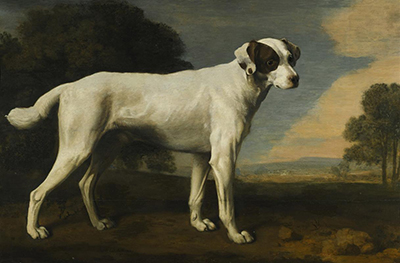Viscount Gormanston's White Dog is an oil painting by George Stubbs. It was commissioned by the 11th Viscount Gormanston of the Gormanston Castle, County Meath in the year 1781.
The art is currently stored at Sotheby's Old Master and British Paintings in London. Viscount Gormanston's White Dog is one of the only two Irish patrons of George Stubbs. The painting was first stored in Gormanston Castle, which was the seat of the Preston family, the bearers of the oldest titles in both Ireland and Britain before being transferred to the Sotheby's Old Master and British Paintings.
In most of his paintings, George Stubbs utilized the freehand drawing technique. He needed more time to paint his art since the animal in the painting required more skills and attention. In this painting, George Stubbs started by drawing the white dog before coming up with the background. He also used the naturalistic style in most of his images, including the Viscount Gormanston's White Dog. Naturalism as a painting style isn't precisely distinguished from realism. They both involve providing a representation of the real world and nature in a convincing manner. In the early 1770s, George Stubbs started to experiment artistically with the enamel paints. After the period of experimentation, George Stubbs returned to oil painting, but he preferred working on the smooth panels instead of canvas.
George Stubbs was influenced by various artists including Sir Josiah Wedgwood, the famous ceramist. During his early years, Stubbs lived with Wedgewood who introduced him to enamel paintings. He helped him create pottery plaques, paintings of Wedgwood family and paintings on ceramics. In 1781, George Stubbs executed the first self-portrait in enamel on a Wedgwood plaque.
Apart from Sir Josiah Wedgwood, George Stubbs's artistic work was also influenced by other artists including William Bliss Baker who was an American painter; they are considered some of the best artworks of the naturalist movement. Other artists related to his work include John Wootton, Sawrey Seymour, Thomas Rowlandson, Jacques Laurent Agasse and Albert Charpin of the famous Barbizon School. He was a French artist who painted various images, including sheep in their natural environment. Paintings by George Stubbs, as well as other related artists, can be found in many art museums across the world, including the National Gallery in London and National Gallery of Art in Washington.




